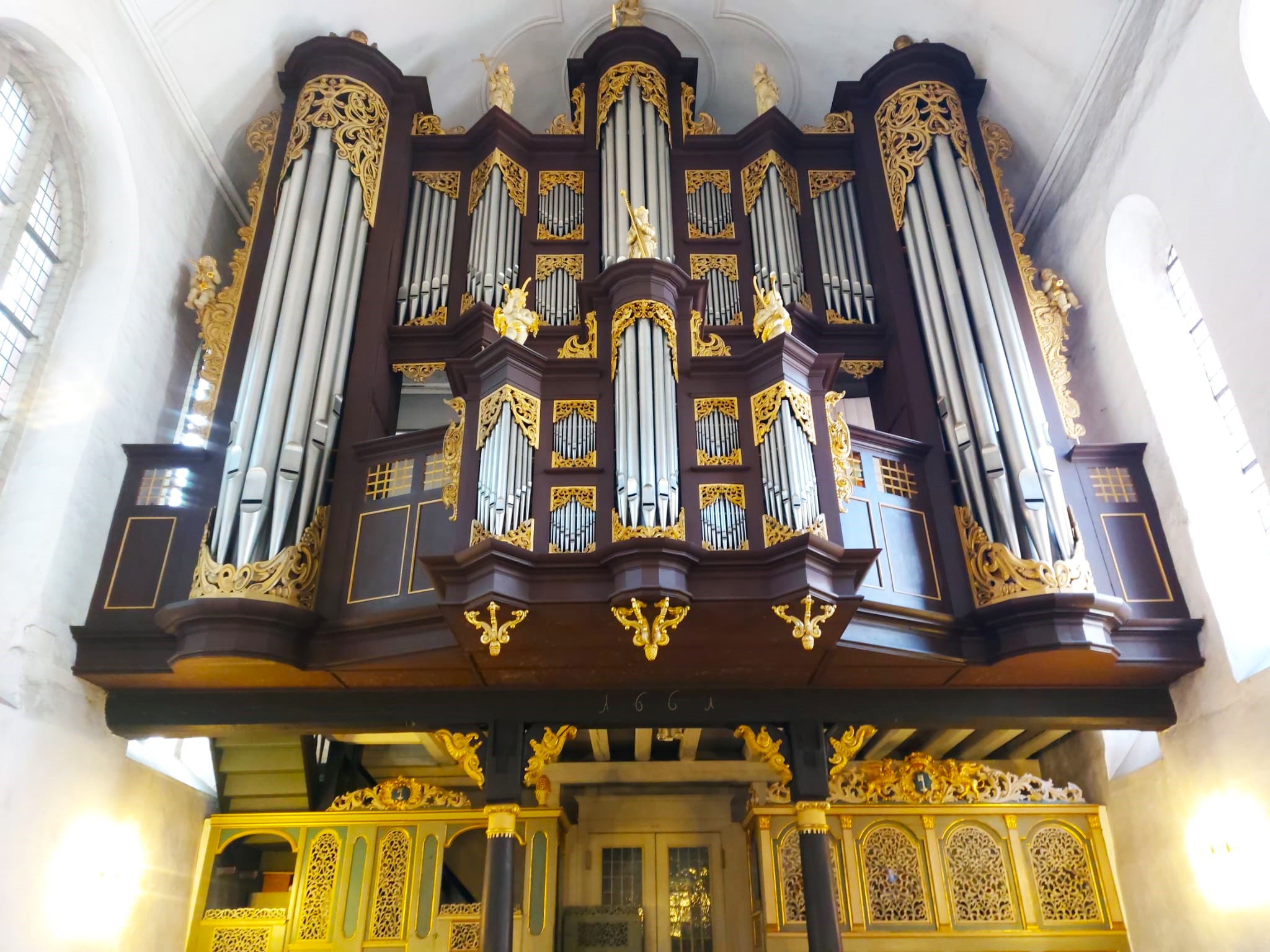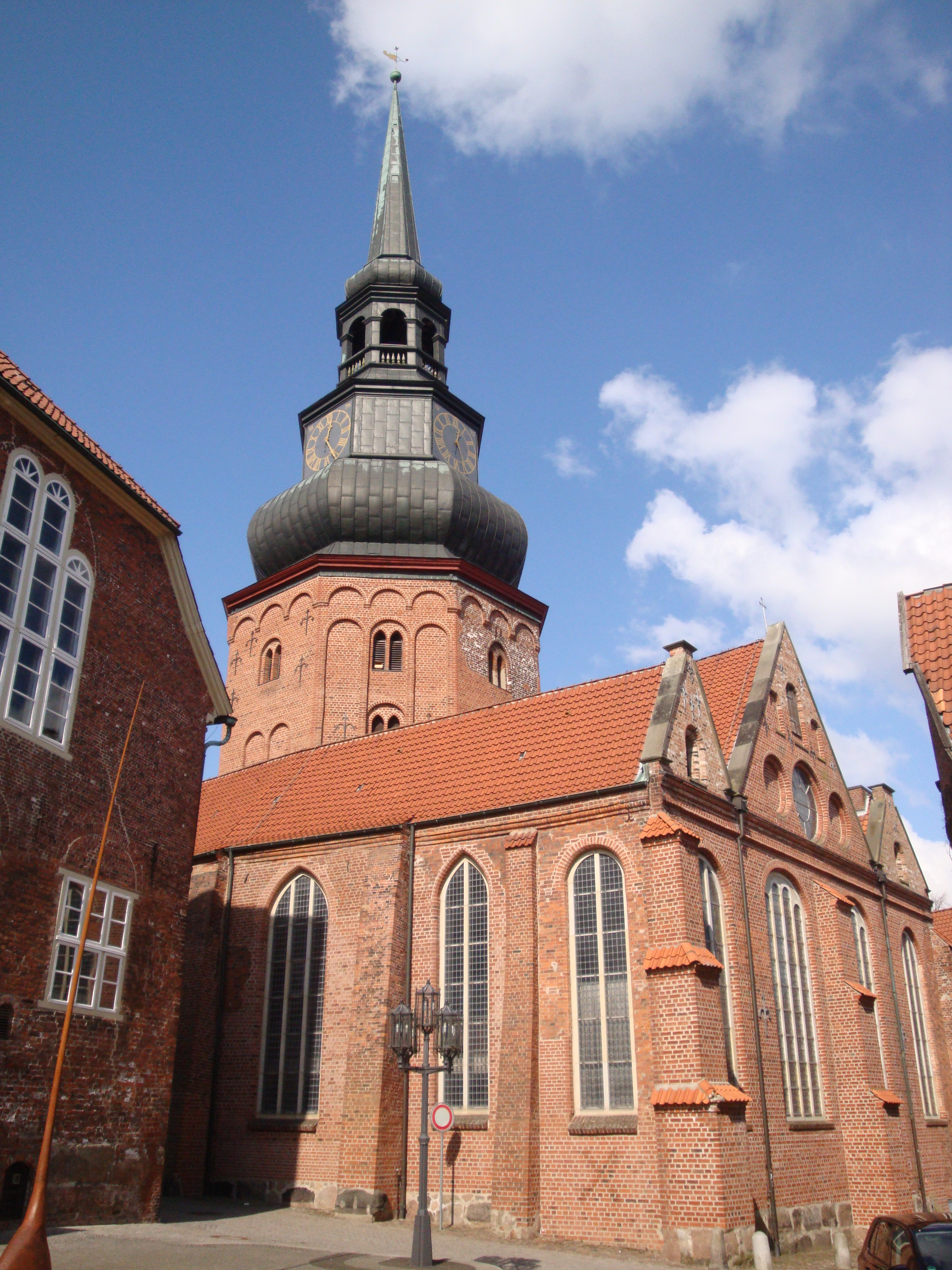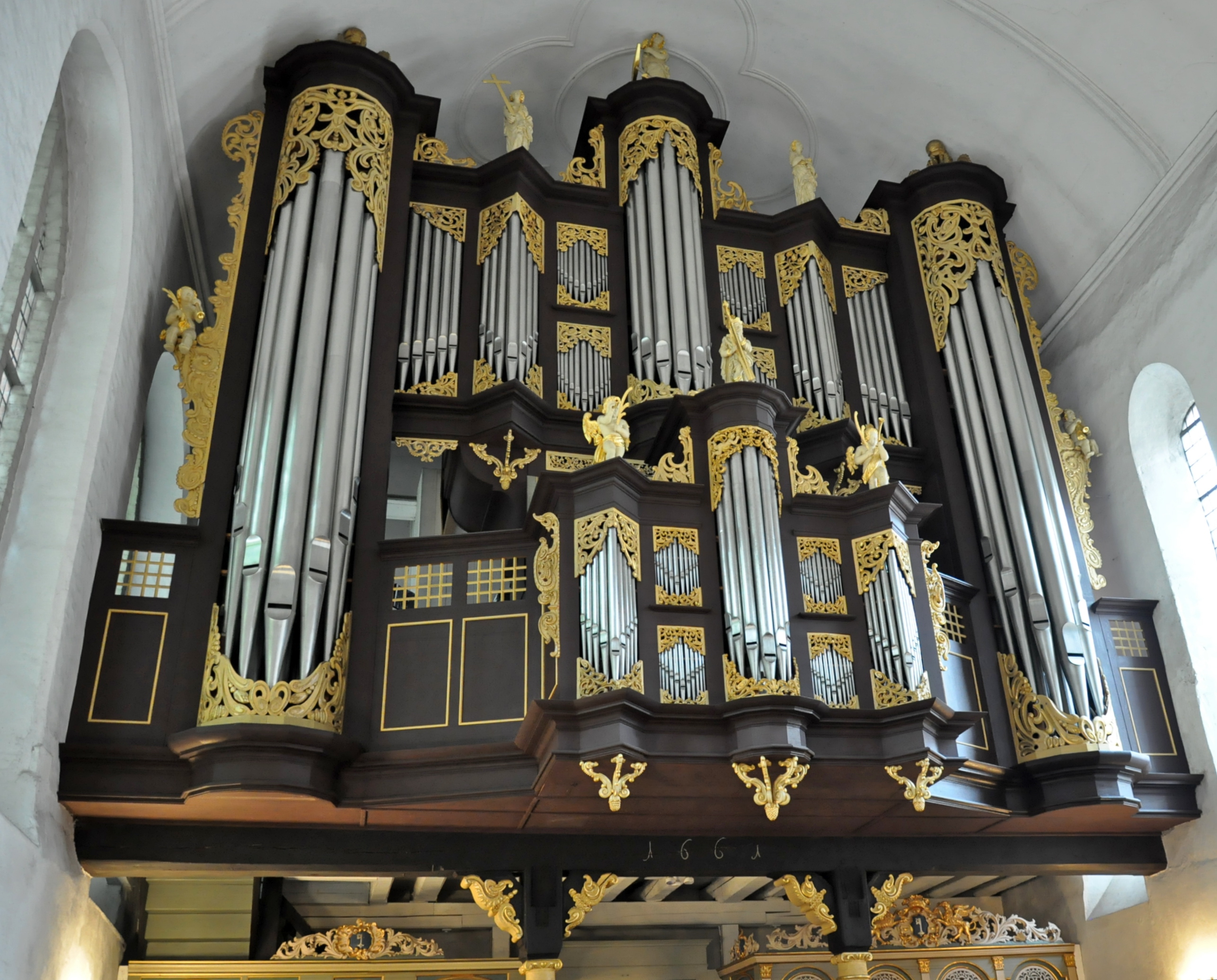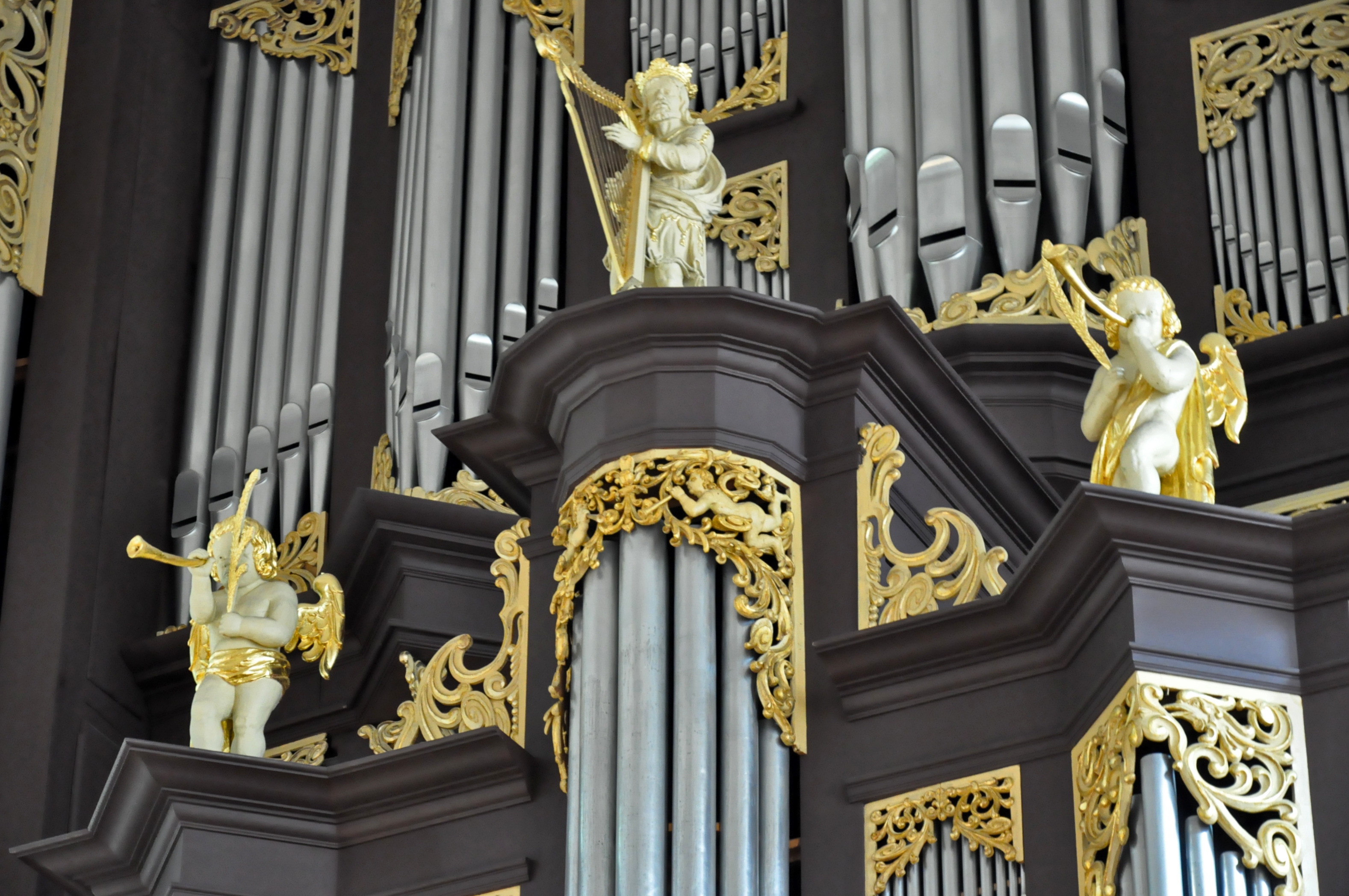Stade, St. Cosmae et Damiani
| Builder | A. Schnitger |
|---|---|
| Year | ca. 1675 |
| Period/Style | Baroque |
| Stops | 43 |
| Keyboards | 3+P |
| Keyaction | tracker/mechanical |
| Tuning | 1/4 Comma Meantone at 493 Hz |
| Sampleset |
Available
 , sampled by
OrganArt Media
, sampled by
OrganArt Media
|
The Hus-Schnitger organ in St. Cosmae, Lower Saxony, with its three manuals and 42 stops on a 16-foot basis, is today considered one of the most significant large North German Baroque organs of its time. It provides insight into the North German organ culture of the 16th and 17th centuries and an authentic representation of the organ compositions of that period. The instrument has an exceptionally large original pipe inventory, with most reed stops remaining original. The first organist was Vincent Lübeck in 1675, who served here for almost 30 years.
After the end of the Thirty Years' War in 1648 (the birth year of Arp Schnitger), which had devastated large parts of Germany culturally, the construction of a large organ like that of St. Cosmae in Stade was a remarkable project of a new era. Stade was the capital of the Swedish Duchies of Bremen and Verden at that time.
After the great city fire of 1659, which also destroyed the Cosmae Church and its predecessor organ, and the subsequent reconstruction, organ builder Berendt Hus was commissioned in 1668 to build a new large organ for St. Cosmae.
In 1666, at the age of 18, Arp Schnitger joined his uncle Hus's workshop. In 1670, Arp Schnitger, 22 years old, was officially mentioned for the first time as a journeyman of Hus. The unusually high salary reflects the special appreciation for Arp Schnitger, who already played an important role in organ building at that time.
The construction took place in various stages; unfortunately, a contract for the entire organ is not preserved. In 1670, the bellows system and the main division (Oberwerk) with double spring chests were completed, and construction of the Rückpositiv began. The facade of the Hus-Schnitger organ shows the typical structure of the so-called Hamburg facade with pedal division, main division, Brustwerk, and Rückpositiv.
In 1671, after the completion of the Rückpositiv, the contract for the pedal division was concluded. The Brustwerk was apparently completed in 1672. The final completion took place in 1675. The instrument has 42 stops and is tuned a whole tone above normal. Arp Schnitger was honored with a gratuity for his valuable contribution. Presumably, on Lübeck's suggestion, Schnitger installed four new stops in 1688: Trommet 16 and Cimbel in the main division, and Krumphorn 8 and Schalmey 4 in the Brustwerk.
Various modifications were made in the following centuries. A systematic restoration was carried out in 1972 by the organ workshop Jürgen Ahrend / Leer-Loga, including the reconstruction of the old gallery and the reconstruction of the Rückpositiv case in the breastwork. Further work was done by the organ workshop Jürgen Ahrend in 1993-94. A new color scheme for the case, based on modern analyses of historical substance, was carried out in 2008.
The instrument clearly bears the hallmarks of both organ builders. While the main division has double spring chests, the Rückpositiv, Brustwerk, and pedal division have slider chests. As far as is known, Hus only built spring chests, while Arp Schnitger opted for slider chests, which are simpler to construct than spring chests.
The pipe work shows a different characteristic than that of the still existing Hus organs. The late Renaissance/early Baroque style of Hus prefers milder tonal colors, while the Schnitger sound exhibits the typical brighter, clearer, and sharper tone, especially of the mixtures, and a high blending ability of the reed stops. All this shows that Arp Schnitger apparently already had a significant influence on the construction of this organ.
The Hus-Schnitger organ is now considered one of the most significant large North German Baroque organs and is the destination for many concerts, organists, organ study trips, and workshops, laying the groundwork for Arp Schnitger's unparalleled career.
After the end of the Thirty Years' War in 1648 (the birth year of Arp Schnitger), which had devastated large parts of Germany culturally, the construction of a large organ like that of St. Cosmae in Stade was a remarkable project of a new era. Stade was the capital of the Swedish Duchies of Bremen and Verden at that time.
After the great city fire of 1659, which also destroyed the Cosmae Church and its predecessor organ, and the subsequent reconstruction, organ builder Berendt Hus was commissioned in 1668 to build a new large organ for St. Cosmae.
In 1666, at the age of 18, Arp Schnitger joined his uncle Hus's workshop. In 1670, Arp Schnitger, 22 years old, was officially mentioned for the first time as a journeyman of Hus. The unusually high salary reflects the special appreciation for Arp Schnitger, who already played an important role in organ building at that time.
The construction took place in various stages; unfortunately, a contract for the entire organ is not preserved. In 1670, the bellows system and the main division (Oberwerk) with double spring chests were completed, and construction of the Rückpositiv began. The facade of the Hus-Schnitger organ shows the typical structure of the so-called Hamburg facade with pedal division, main division, Brustwerk, and Rückpositiv.
In 1671, after the completion of the Rückpositiv, the contract for the pedal division was concluded. The Brustwerk was apparently completed in 1672. The final completion took place in 1675. The instrument has 42 stops and is tuned a whole tone above normal. Arp Schnitger was honored with a gratuity for his valuable contribution. Presumably, on Lübeck's suggestion, Schnitger installed four new stops in 1688: Trommet 16 and Cimbel in the main division, and Krumphorn 8 and Schalmey 4 in the Brustwerk.
Various modifications were made in the following centuries. A systematic restoration was carried out in 1972 by the organ workshop Jürgen Ahrend / Leer-Loga, including the reconstruction of the old gallery and the reconstruction of the Rückpositiv case in the breastwork. Further work was done by the organ workshop Jürgen Ahrend in 1993-94. A new color scheme for the case, based on modern analyses of historical substance, was carried out in 2008.
The instrument clearly bears the hallmarks of both organ builders. While the main division has double spring chests, the Rückpositiv, Brustwerk, and pedal division have slider chests. As far as is known, Hus only built spring chests, while Arp Schnitger opted for slider chests, which are simpler to construct than spring chests.
The pipe work shows a different characteristic than that of the still existing Hus organs. The late Renaissance/early Baroque style of Hus prefers milder tonal colors, while the Schnitger sound exhibits the typical brighter, clearer, and sharper tone, especially of the mixtures, and a high blending ability of the reed stops. All this shows that Arp Schnitger apparently already had a significant influence on the construction of this organ.
The Hus-Schnitger organ is now considered one of the most significant large North German Baroque organs and is the destination for many concerts, organists, organ study trips, and workshops, laying the groundwork for Arp Schnitger's unparalleled career.
| Rückpositiv | Oberwerk | Brustwerk | Pedalwerk |
|---|---|---|---|
| Principal 8' | Principal 16' | Gedackt 8' | Principal 16' |
| Rohrflöt 8' | Quintadena 16' | Querflöt 8' | Sub-Baß 16' |
| Quintadena 8' | Octav 8' | Flöt 4' | Octav 8' |
| Octav 4' | Gedackt 8' | Octav 2' | Octav 4' |
| Waltflöt 2' | Octav 4' | Tertia 1 3/5' | Nachthorn 1' |
| Sieflöt 1 1/3' | Rohrflöt 4' | Nassat Quint 1 1/3' | Mixtur V-VI 1 1/3' |
| Sesquialtera II 1 1/3' | Nasat 3' | Sedetz 1' | Posaun 16' |
| Scharff V 1' | Octav 2' | Scharff III 2/3' | Dulcian 16' |
| Dulcian 16' | Mixtur VI 1' | Krumphorn 8' | Trommet 8' |
| Trechter Regal 8' | Cimbel III | Schalmey 4' | Cornet 2' |
| Trommet 16' | |||
| Trommet 8' | |||
| Glockenspiel (18. Jh.) |
https://organindex.de/index.php?title=Stade,_St._Cosmae_et_Damiani#cite_note-1
https://www.organartmedia.com/de/hus-arp-schnitger
https://www.organartmedia.com/de/hus-arp-schnitger
 Pipe Organ Map
Pipe Organ Map


